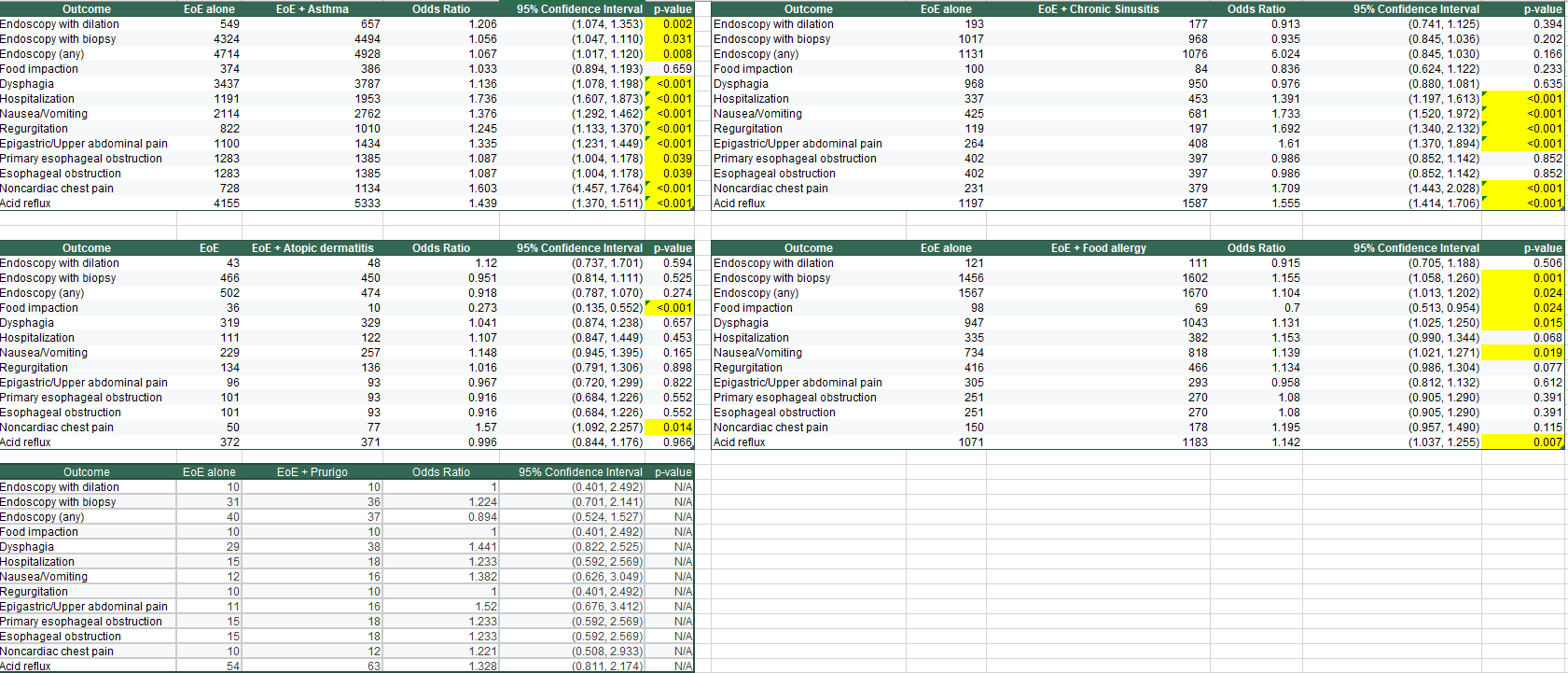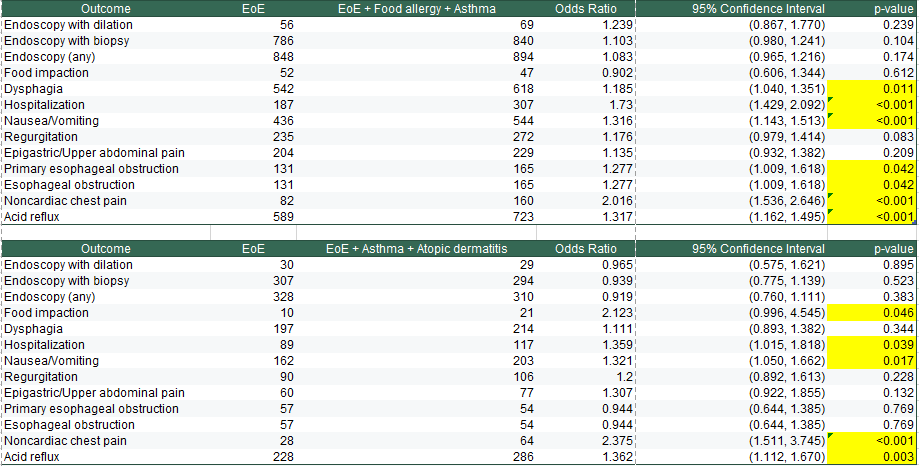Tuesday Poster Session
Category: Esophagus
P4947 - Clinical Outcomes in Eosinophilic Esophagitis Patients With and Without Atopic Comorbidities: A Multicenter Retrospective Analysis
Tuesday, October 28, 2025
10:30 AM - 4:00 PM PDT
Location: Exhibit Hall
- FT
Fadi Totah, DO
Riverside Community Hospital
Riverside, CA
Presenting Author(s)
Fadi Totah, DO1, Rakahn Haddadin, MD2, Eric H. Choi, MD, FACG3
1Riverside Community Hospital, Riverside, CA; 2HCA Healthcare MountainView Hospital, Las Vegas, NV; 3HCA Healthcare Riverside Community Hospital, Riverside, CA
Introduction: Eosinophilic esophagitis (EoE) is a chronic immune-mediated condition characterized by eosinophil-predominant inflammation of the esophagus. EoE frequently coexists with atopic conditions such as asthma, food allergies, atopic dermatitis, chronic sinusitis, and prurigo nodularis. However, the impact of individual and multiple atopic comorbidities on EoE-related clinical outcomes remains incompletely characterized. We aimed to compare clinical outcomes in EoE patients with versus without atopic comorbidities using real-world data.
Methods: We performed a retrospective cohort analysis using the TriNetX database, a global federated health research network encompassing 69 healthcare organizations. Patients with EoE were categorized based on the presence or absence of comorbid atopic conditions. Outcomes included hospitalization, food impaction, endoscopy, dysphagia, chest pain, regurgitation, nausea/vomiting, and acid reflux. Inverse odds ratios (iORs) were calculated to reflect risk in the EoE + atopy group relative to EoE alone.
Results: Across seven comparisons, EoE patients with atopic comorbidities had greater odds of adverse outcomes than those with EoE alone. Asthma was linked to higher odds of hospitalization (1.736, p< 0.001), dysphagia (1.136), nausea/vomiting (1.376), chest pain (1.603), and reflux (1.439) (all p< 0.001). Food allergy was associated with increased dysphagia (1.131, p=0.015), nausea/vomiting (1.139, p=0.019), and reflux (1.142, p=0.007), but reduced food impaction (0.700, p=0.024). Atopic dermatitis was tied to less food impaction (0.273, p< 0.001) and more chest pain (1.570, p=0.014). Chronic sinusitis was linked to several symptoms, including hospitalization (1.391, p< 0.001). Prurigo showed no significant differences. Multiple atopic conditions increased odds of food impaction (2.123, p=0.046), chest pain (2.375, p< 0.001), and hospitalization (1.359, p=0.039).
Discussion: EoE patients with atopic comorbidities—particularly asthma, food allergy, and chronic sinusitis—face significantly higher odds of hospitalization, GI symptoms, and food impaction. Risk is further elevated with multiple atopic conditions, such as asthma combined with food allergy or atopic dermatitis. These findings suggest a more severe EoE phenotype, warranting more aggressive or tailored management. Future strategies should integrate atopic profiles into risk stratification to enable personalized care and closer monitoring.

Figure: Table 1. Comparison of clinical outcomes in EoE patients with versus without atopic comorbidities—including asthma, atopic dermatitis, food allergy, chronic rhinosinusitis, and prurigo nodularis

Figure: Table 2. Comparison of clinical outcomes in EoE patients with versus without multiple combined atopic comorbidities—including asthma with food allergy and asthma with atopic dermatitis
Disclosures:
Fadi Totah indicated no relevant financial relationships.
Rakahn Haddadin indicated no relevant financial relationships.
Eric H. Choi indicated no relevant financial relationships.
Fadi Totah, DO1, Rakahn Haddadin, MD2, Eric H. Choi, MD, FACG3. P4947 - Clinical Outcomes in Eosinophilic Esophagitis Patients With and Without Atopic Comorbidities: A Multicenter Retrospective Analysis, ACG 2025 Annual Scientific Meeting Abstracts. Phoenix, AZ: American College of Gastroenterology.
1Riverside Community Hospital, Riverside, CA; 2HCA Healthcare MountainView Hospital, Las Vegas, NV; 3HCA Healthcare Riverside Community Hospital, Riverside, CA
Introduction: Eosinophilic esophagitis (EoE) is a chronic immune-mediated condition characterized by eosinophil-predominant inflammation of the esophagus. EoE frequently coexists with atopic conditions such as asthma, food allergies, atopic dermatitis, chronic sinusitis, and prurigo nodularis. However, the impact of individual and multiple atopic comorbidities on EoE-related clinical outcomes remains incompletely characterized. We aimed to compare clinical outcomes in EoE patients with versus without atopic comorbidities using real-world data.
Methods: We performed a retrospective cohort analysis using the TriNetX database, a global federated health research network encompassing 69 healthcare organizations. Patients with EoE were categorized based on the presence or absence of comorbid atopic conditions. Outcomes included hospitalization, food impaction, endoscopy, dysphagia, chest pain, regurgitation, nausea/vomiting, and acid reflux. Inverse odds ratios (iORs) were calculated to reflect risk in the EoE + atopy group relative to EoE alone.
Results: Across seven comparisons, EoE patients with atopic comorbidities had greater odds of adverse outcomes than those with EoE alone. Asthma was linked to higher odds of hospitalization (1.736, p< 0.001), dysphagia (1.136), nausea/vomiting (1.376), chest pain (1.603), and reflux (1.439) (all p< 0.001). Food allergy was associated with increased dysphagia (1.131, p=0.015), nausea/vomiting (1.139, p=0.019), and reflux (1.142, p=0.007), but reduced food impaction (0.700, p=0.024). Atopic dermatitis was tied to less food impaction (0.273, p< 0.001) and more chest pain (1.570, p=0.014). Chronic sinusitis was linked to several symptoms, including hospitalization (1.391, p< 0.001). Prurigo showed no significant differences. Multiple atopic conditions increased odds of food impaction (2.123, p=0.046), chest pain (2.375, p< 0.001), and hospitalization (1.359, p=0.039).
Discussion: EoE patients with atopic comorbidities—particularly asthma, food allergy, and chronic sinusitis—face significantly higher odds of hospitalization, GI symptoms, and food impaction. Risk is further elevated with multiple atopic conditions, such as asthma combined with food allergy or atopic dermatitis. These findings suggest a more severe EoE phenotype, warranting more aggressive or tailored management. Future strategies should integrate atopic profiles into risk stratification to enable personalized care and closer monitoring.

Figure: Table 1. Comparison of clinical outcomes in EoE patients with versus without atopic comorbidities—including asthma, atopic dermatitis, food allergy, chronic rhinosinusitis, and prurigo nodularis

Figure: Table 2. Comparison of clinical outcomes in EoE patients with versus without multiple combined atopic comorbidities—including asthma with food allergy and asthma with atopic dermatitis
Disclosures:
Fadi Totah indicated no relevant financial relationships.
Rakahn Haddadin indicated no relevant financial relationships.
Eric H. Choi indicated no relevant financial relationships.
Fadi Totah, DO1, Rakahn Haddadin, MD2, Eric H. Choi, MD, FACG3. P4947 - Clinical Outcomes in Eosinophilic Esophagitis Patients With and Without Atopic Comorbidities: A Multicenter Retrospective Analysis, ACG 2025 Annual Scientific Meeting Abstracts. Phoenix, AZ: American College of Gastroenterology.
